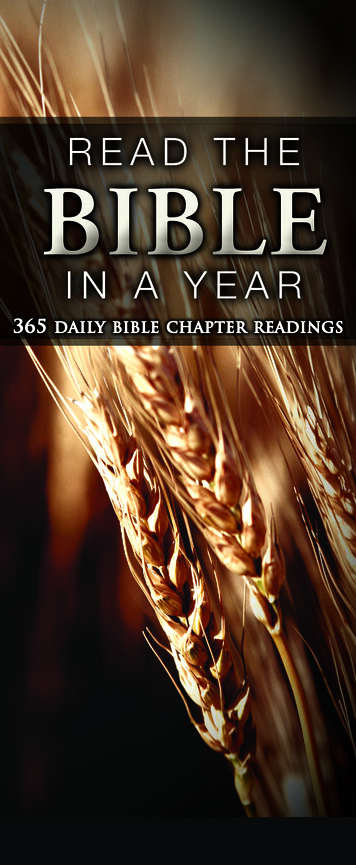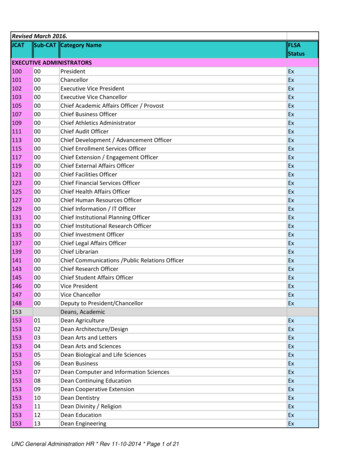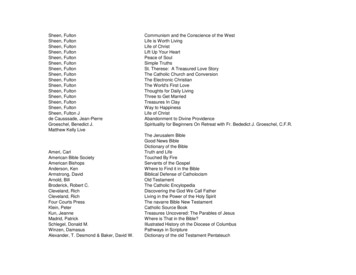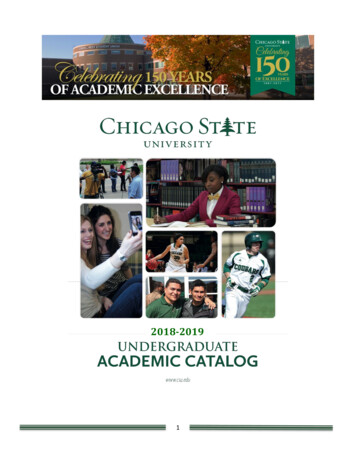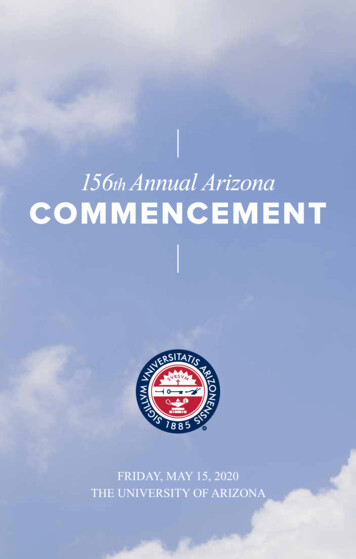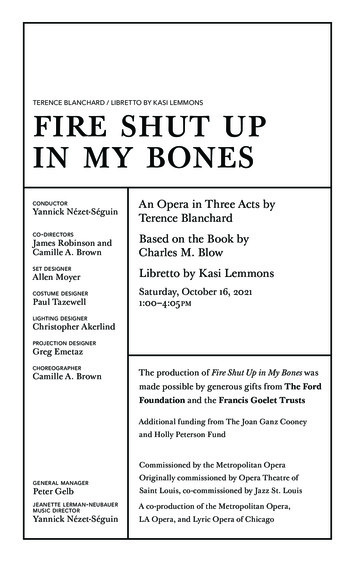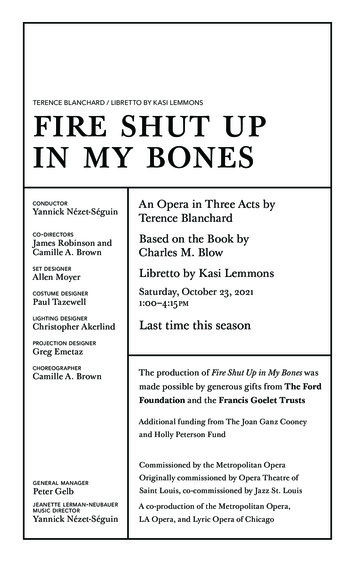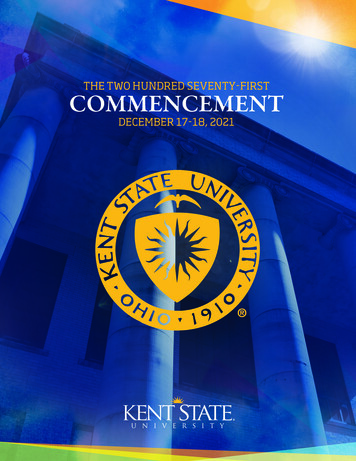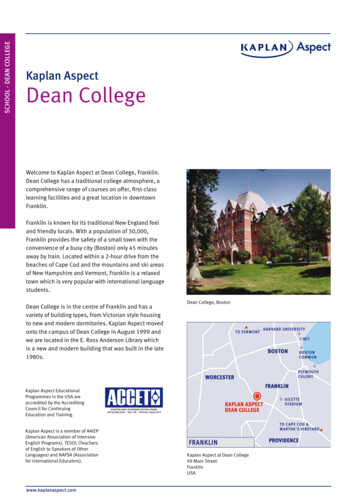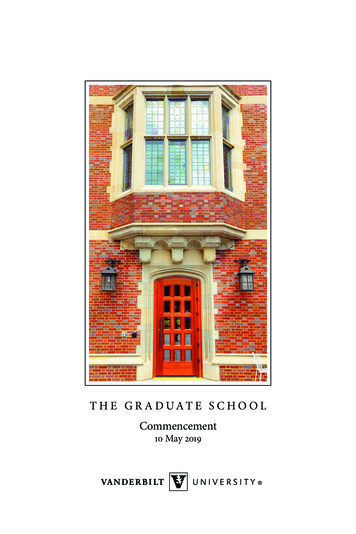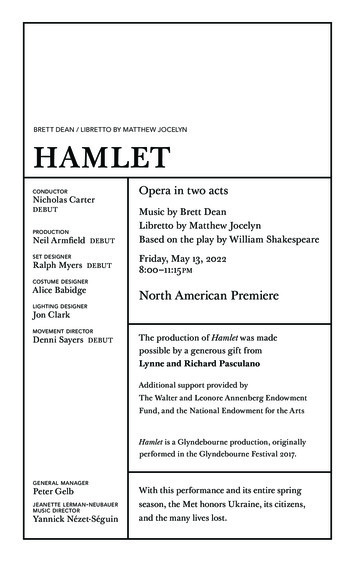
Transcription
hamletBRETT DEAN / LIBRETTO BY MATTHEW JOCELYNconductorNicholas CarterDEBUTproductionNeil ArmfieldDEBUTset designerRalph MyersDEBUTOpera in two actsMusic by Brett DeanLibretto by Matthew JocelynBased on the play by William ShakespeareFriday, May 13, 20228:00–11:15 pmcostume designerAlice BabidgeNorth American Premierelighting designerJon Clarkmovement directorDenni SayersDEBUTThe production of Hamlet was madepossible by a generous gift fromLynne and Richard PasculanoAdditional support provided byThe Walter and Leonore Annenberg EndowmentFund, and the National Endowment for the ArtsHamlet is a Glyndebourne production, originallyperformed in the Glyndebourne Festival 2017.general managerPeter GelbWith this performance and its entire springjeanette lerman - neubauermusic directorseason, the Met honors Ukraine, its citizens,Yannick Nézet-Séguinand the many lives lost.
2021–22seasonThe North American premiere ofhamletBRETT DEAN’Sco n duc to rNicholas CarterDEBUTin order of vocal appearancehamletAllan Claytongu i l d en s t er nDEBUTDEBUTcl au d i u sRod Gilfrypl ay er sJohn RelyeaManase Latu** DEBUTChad SheltonJustin Austin DEBUTl a er t e sDavid Butt Philipo ph el i aBrenda Raeg r av e d i gg erJohn Relyeap o lo n i u sWilliam Burdenh o r at i oJacques ImbrailoDEBUTm a r cel lu sJustin AustinDEBUTg er t r u d eSarah ConnollyThis performanceis being broadcastlive on MetropolitanOpera Radio onSiriusXM channel355 and streamedat metopera.org.Christopher Lowreyo ff s tag e vo i ce sMonica Dewey DEBUTChanáe CurtisTesia Kwarteng DEBUTMegan Moore DEBUTJohn Matthew MyersDEBUTJohn RelyeaChristian Mark GibbsBenjamin Sieverdingr os en cr a n t zDEBUTghostAryeh Nussbaum CohenDEBUTWm. Clay ThompsonDEBUTacco r d i o nVeli KujalaFriday, May 13, 2022, 8:00–11:15PM
Chorus Master David MoodyDramaturg Cori EllisonMusical Preparation Bryan Wagorn*, Dimitri Dover*,Israel Gursky, and Viswa SubbaramanAssistant Stage Directors Gina Lapinski and Paula SuozziOriginal Fight Director Nicholas HallRevival Fight Director Joe IsenbergElectronic Sounds Timothy Constable, percussion;Francesco Celata, clarinet; Benjamin Schwartz, cello;Bob Scott, producer and recording engineer; andBrett Dean, musical directionIntimacy Direction Rocio Mendez and Doug Scholz-CarlsonEnglish Coach Kathryn LaBouffPrompter Israel GurskyMet Titles Michael PanayosSpecial thanks to Banff Centre for Arts and CreativityScenery, properties, and electrical props constructedand painted by Cardiff Theatrical Services,Glyndebourne Festival Opera Shops, andMetropolitan Opera ShopsCostumes constructed by Glyndebourne Festival OperaCostume Shop and Metropolitan Opera CostumeDepartmentWigs and Makeup constructed and executed by MetropolitanOpera Wig and Makeup DepartmentHamlet is performed by agreement with Bote & Bock Berlinand Boosey & Hawkes, Inc.This performance is made possible in part by public fundsfrom the New York State Council on the Arts.Before the performance begins, please switch off cell phonesand other electronic devices.Please remember that face masks are required at all timesinside the Met.* Graduate of theLindemann Young ArtistDevelopment Program** Member of theLindemann Young ArtistDevelopment ProgramYamaha is theOfficial Piano of theMetropolitan Opera.Visit metopera.org.Met TitlesTo activate, press the red button to the right of the screen in front ofyour seat and follow the instructions provided. To turn off the display,press the red button once again. If you have questions, please ask anusher at intermission.
2021–22 SeaSonNadine Sierra in the title role ofDonizetti’s Lucia di LammermoorThe Metropolitan Opera is pleased to saluteBloomberg Philanthropies in recognition of itsgenerous support during the 2021–22 season.PHOTO: ZENITH RICHARDS / MET OPERA
SynopsisAct IElsinore, Denmark. King Hamlet has died, mourned by his son, Prince Hamletof Denmark. The king’s funeral is followed fast by the marriage of his widow,Gertrude, to his brother, Claudius. Hamlet is deeply disturbed by his father’suntimely death and his mother’s “o’er hasty marriage,” a state aggravated bythe appearance of King Hamlet’s ghost, who informs Hamlet that he was in factmurdered by his brother, now husband to Gertrude and King of Denmark. Thedead king asks that his son avenge his death by killing Claudius.Thrown into an emotional abyss and sensing himself surounded by spiesand enemies, Hamlet rejects his soulmate and lover, Ophelia, and dismisseshis former classmates Rosencrantz and Guildenstern, whom Claudius hassummoned to Elsinore to help discover the cause of Hamlet’s erratic behavior.A group of players arrives at Elsinore. Hamlet asks them to perform a scenemimicking the murder of King Hamlet by his brother. Claudius reacts violentlyto the performance, proof in Hamlet’s eyes of his stepfather’s guilt. Called to hismother’s chamber to explain his actions, Hamlet comes upon Claudius deep inprayer but pulls himself back from his impulse to kill him.Once again with his mother, Hamlet hears a muffled cry and, thinking it’sClaudius spying on him, kills the unsuspecting Polonius, Ophelia’s father. Hamletthen berates his mother for her betrayal of his father. His father’s ghost appears,reminding Hamlet of his primary mission: vengeance on Claudius.Intermission(aT APPROXIMATELY 9:45PM)Act IILaertes, Polonius’s son, returns to Elsinore to avenge his father’s death,threatening Claudius and his kingship. Claudius manages to allay Laertes’shostility by convincing him that Hamlet is the guilty one: Together, Claudius andLaertes conspire to kill him.Ophelia appears, apparently driven mad by Hamlet’s rejection and the death ofher father. This only serves to harden Laertes’s resolve for vengeance, as does,moments later, Ophelia’s death—she has drowned herself.Hamlet and his friend Horatio witness Ophelia’s funeral procession, and uponlearning of her death, Hamlet provokes Laertes.Visit metopera.org.39
SynopsisCONTINUEDThrough the intermediaries Rosencrantz and Guildenstern, and according tothe plan concocted with Claudius, Laertes challenges Hamlet to a duel. Hamletaccepts the challenge.Many deaths ensue.Synopsis by Matthew Jocelyn and Neil ArmfieldShakespeare on DemandLooking for more operas inspired by the works of Shakespeare?Check out Met Opera on Demand, our online streaming service,to enjoy outstanding presentations from past Met seasons,including Live in HD transmissions of Verdi’s Macbeth and Otello,Gounod’s Roméo et Juliette, and Thomas Adès The Tempest—aswell as Ambroise Thomas’s own moving adaption of Hamlet. Startyour seven-day free trial and explore the full catalog of more than750 complete performances at metoperaondemand.org.40
In FocusBrett DeanHamletPremiere: Glyndebourne Festival Opera, Lewes, 2017The dramatic works of William Shakespeare have inspired composers throughouthistory—from 19th-century Romantics like Bellini, Verdi, and Gounod to modernmasters such as Britten, Barber, Bernstein, and Thomas Adès. This musicallegacy continues with Hamlet, Australian composer Brett Dean’s adaptation ofarguably the greatest—and most quoted—of all of Shakespeare’s plays. TheBard’s immortal tragedy of a young Danish prince determined to avenge hisfather’s murder at the hand of his uncle and new stepfather, King Claudius—butalso trapped by his own inability to act—is among theater’s most captivating andconvincing psychological portraits. Following a gripping opening monologuefor the title character, Dean’s “version” is a relatively faithful retelling of the story,but the incorporation of music—including tour-de-force vocal writing, imposingchoral forces, and a richly textured, often unnerving orchestral palette—ratchetsup the tension of this classic tale and results in a thoroughly riveting dramaticexperience.The CreatorsPreviously a violist in the Berlin Philharmonic for 14 years, Brett Dean (b. 1961) isone of today’s most prominent composers, with a body of work encompassingorchestral, choral, chamber, and vocal works, as well as concerti for a variety ofsolo instruments. Hamlet is his second opera, following Bliss, which premieredin 2010. Matthew Jocelyn (b. 1958), who crafted the opera’s text, is a Canadiandirector, translator, and librettist who served as artistic and general director ofCanadian Stage from 2009 to 2018. While the material is sometimes rearrangedor sung by other characters than those in the source text, nearly all of thewords in Jocelyn’s libretto are by William Shakespeare (1564–1616), the prolificplaywright whose numerous masterpieces—including comedies, tragedies, andpoetry—stand as history’s greatest showcases of the English language and itslinguistic possibilities. Even beyond the English-speaking world, it is difficultto overestimate the profound impact that Shakespeare’s works have had onreaders, audiences, and artists for the last four centuries.The SettingLike the original play, which unfolds in an imprecise period in Elsinore Castlein medieval Denmark, Dean’s opera is set in an imagined Elsinore at anindeterminate date. This production, by Neil Armfield, draws upon visual motifsVisit metopera.org.41
In FocusCONTINUEDof the 18th and 20th centuries to create a simultaneously modern and timelessfeel for the action.The MusicTo express the power, complexity, and ambivalence of Shakespeare’sunparalleled text, Dean employs a musical language that is by turns brash,dissonant, eerily beautiful, and humorous. The music for the ghost of Hamlet’sfather, for example, manages to be both subtly evocative and unsettling, whilethe sycophants Rosencrantz and Guildenstern are cast as countertenors oftensinging in unison, exploring the comic and insinuating natures of the enigmaticpair. In addition to a full opera orchestra, the score calls for a large percussionsection, electronic instruments, and unusual sound effects. Additionally, Deansets two small satellite groups of musicians—each comprising clarinet, trumpet,and percussion array—in the auditorium to further immerse the audience in thedrama. The onstage chorus is featured prominently, while in the orchestra pit, asemi-chorus of eight singers acts as a kind of sonic echo of the action. The vocalwriting presents great challenges for all of the lead characters, none more sothan Ophelia, whose extended virtuosic mad scene in the second act carrieson the centuries-old tradition of operatic mad scenes. The title role is likewisedemanding, but in a very different manner: From the very first bars to the finalduel, Hamlet is a practically omnipresent figure, rarely leaving the stage andengaging in fraught confrontations with many of the other characters—as wellas with his own inner demons.Met HistoryThis season’s performances mark Hamlet’s North American premiere. AllanClayton, who originated the title role in the work’s world premiere, stars asHamlet, alongside Brenda Rae as Ophelia, Sarah Connolly as Gertrude, RodGilfry as Claudius, and bass-baritone John Relyea as the Ghost, the First Player,and the Gravedigger, with Nicholas Carter making his Met debut on the podium.42
Program NoteT“here’s a quote by the great German composer Wolfgang Rihm that Ialways come back to,” says composer Brett Dean. “‘Remember that allmusic, all sound, is theater.’” It’s a quotation that could be the motto forHamlet—the opera that Dean spent five years bringing to vivid theatrical life.“To experience Hamlet is not to watch a performance, or to see a musicaladaptation of Shakespeare’s play, but to find yourself living it. Placing hisaudience at the heart of the drama, immersing us in sound and even physicalsensation, Dean invites us all into Hamlet’s consciousness, to inhabit the mind ofone of the wittiest, most clever, most troubled heroes in all literature.But while reimagining Shakespeare’s great tragedy offers huge possibilities,working with such an iconic text also brings with it certain challenges, as Deanhimself acknowledges:When someone first suggested Hamlet as a possible subject for an opera,I was actually very skeptical of the idea. My initial response was to sayno, that I couldn’t possibly tackle something that big. But once I got overthe “Oh my God, Hamlet!” stage (which was pretty much the reaction ofeveryone I told) I began to realize how utterly gripping it was as a text,especially after I started setting some of the words. Hamlet is just somusical—so full of rhythm and possibility—that I was just mesmerized.The biggest lesson that I took away from composing my first opera, Bliss,was to make sure that whatever text or topic I chose next, it had to besomething that I was completely passionate about, that I could live with foryears of my life. You really have to invest heavily in whatever you choose, somake sure that you choose something worth investing in. Hamlet gives youback everything you put in and more.A large part of Hamlet’s appeal, both for Dean and librettist MatthewJocelyn, was its dramatic fluidity, its flexibility. With three surviving texts—thetwo Quartos and the Folio—each differing substantially from the others, anyperformance of the play starts with a creative act: assembling the hero from themany pieces of this jigsaw text. Is Hamlet mad or merely feigning madness? Ishis indecisiveness the product of weakness or wisdom? These are questions thetext not only allows but actively invites—less a matter of “To be, or not to be”than “Whom to be?”For Dean, the answer was driven by one overriding factor: sympathy. “Ifyou don’t sympathize with Hamlet,” he explains, “then it’s an impressive piecebut not necessarily a moving one. It was important for us to show what a vital,witty, firecracker of a young man he is, how he comes to life when the playersarrive—because that’s what makes his eventual decline so heart wrenching. OurVisit metopera.org.42A
Program NoteCONTINUEDHamlet is a poet, a person who is on a cusp of various kinds—madness and notmadness being one, but also the will to live or not, being in love or out of it.”Those same ambiguities were also the starting point for librettist MatthewJocelyn. “My Hamlet is mercurial—he is whoever the director and the singer canmine from the material. In our Hamlet, the musical text is just as strong as theverbal text, so character is built not just through words but through sounds—thevibration of that music, its emotional arc, the friction between it and the wordsit sets.”Creating a sound world was a process that came easily for Dean, and,unusually, many of his earliest musical thoughts and ideas still survive in thefinished opera. Hamlet would eventually become an extremely large andambitious score, but Dean’s starting point was a simple one. “I wanted to reallylive the play’s emotional terrain,” he says, “to let myself follow all its ebbs andflows and explore all its nooks, crannies, and rivulets. I pursued a style of vocalwriting that would unashamedly include the physical sounds of emotion, ofshock or hurt or exasperation or love—gasps and sighs, yearning glissandi.”The result is visceral and intensely dramatic, a musical language that bypassesthe head and goes straight for the heart. When we hear Ophelia’s guttural criesof anguish, barely sung as she struggles to find her voice against the torrentialforce of Hamlet’s anger, we do not need to understand her words to know whatshe feels. Similarly, the twittering imitation of Rosencrantz and Guildenstern, inits ornate affectation, tells us all we need to know about this pair of obsequiousflatterers.But the voices are only the start of a score that spills out from the orchestrapit, transforming the entire auditorium into what Dean describes as a “theaterof sound.” Two instrumental trios are positioned in auditorium side boxes,creating literal surround sound, and a small group of vocalists sings from thepit, while subwoofers add electronic sounds and vibrations to the orchestralscore. The effect is immersive and disorienting—music that blurs the distinctionbetween voice and instrument, sound and music, acoustic and electronicsounds, catching the glorious confusion of a mind in which imagination andreality are one and the same.One of the most striking aspects of Dean’s score is its use of percussion.Read down the list of instruments, and alongside drums and tuned percussionyou’ll find some unusual entries, including plastic bottles, stones, sandpaper,aluminum foil, and even a frying pan. They all add to a sonic landscape thatcelebrates the alien, the unexpected. The otherworldly presence of the ghost isthere from the very first bars—a moment Dean was particularly keen to get right.I love that hush of expectation when the lights go down, and what you dowith that moment is really critical. What you hear in those first few seconds of42B
the piece, in those electronic rumblings, is actually a tam-tam being strokedwith a hard rubber ball. It’s one of the most chilling, most disconcertinglybeautiful sounds imaginable, and the idea of that sound emerging into adarkened auditorium was something that excited me from the very start ofthe project.The challenge for director Neil Armfield, whose long association withShakespeare’s play includes a career-defining Sydney production starringRichard Roxburgh, Geoffrey Rush, and Cate Blanchett, was to find a visuallanguage for Hamlet to match Dean’s unapologetically contemporary score.“There was no question in my mind,” he says, “that this would ever be anythingother than a contemporary court. With such a modern musical idiom, it makesno sense to go historical in the setting. I see Gertrude and Claudius as theleaders of a very fashionable crowd and drew visually on the 1960s as a way ofunifying and giving elegance to them. I wanted the audience to get a strongsense of the immediacy of the story.”The result is a staging that alludes to many eras without explicitly inhabitingany of them, that sets Ralph Myers’s elegant period interiors in striking visualcounterpoint with 20th-century fashions. At the center of it all is Hamlet himself,a man who seems to belong neither to one world or another, a timeless figure ina dark overcoat, whose inner life dwarfs his outer existence completely, graduallyswallowing him up as the drama progresses, just as darkness gradually engulfsthe initial radiance of Jon Clark’s lighting design.Working with a newly commissioned score is a very different business todirecting an established opera, changing the normal process for both Armfieldand Dean. “Brett would ask me, ‘Do you want to tell me how long you needfor scene changes?,’ but I thought that the idea of composing a score to fit aproduction that didn’t yet exist would be disastrous,” Armfield says. “We decidedinstead to create a set that would allow for swift, fluid movement from one sceneto another, and that became one of the pleasures of the production.”Ten years since the project first began, and there’s no sign that Dean,Armfield, or any of the Hamlet collaborators are growing weary of their material.The enduring appeal of Shakespeare’s play is reflected in the hundreds ofproductions that are staged annually around the world, and in the films,television adaptations, novels, and dissertations it continues to inspire. Likewise,says Dean, translating Hamlet to the operatic stage offers another valuableperspective on one of history’s great masterpieces:Experiencing the opera sonically has a completely different impact tohearing the play spoken. Having an orchestra of nearly 80 players and achorus of 40, as well as the electronics, does give it a weight that onlyVisit metopera.org.42C
Program NoteCONTINUEDopera can really have. I also think that the unique capacity of music—thatyou can have multiple voices singing in harmony or singing different textssimultaneously—brings with it an emotional depth, and provokes a newresponse in the listener. It’s not a question of whether the opera is betteror not as good as the play, it’s just a different experience of Hamlet, andthat’s fascinating in and of itself.—Alexandra CoghlanAlexandra Coghlan is a classical music journalist, and writes regularly forpublications including The Spectator, Prospect, Gramophone and Operamagazines, the Independent, and the I Paper. She is Glyndebourne’sopera specialist. Glyndebourne Productions Ltd. Reprinted here with permission42D
The Cast and Creative TeamBrett Deancomposer (brisbane, australia )career highlights Winning both the 2018 South Bank Sky Arts Award and International OperaAward for Best New Opera, Hamlet is Brett Dean’s second opera, following Bliss, whichpremiered in 2010. He studied in Brisbane before moving to Germany in 1984, where hewas a violist with the Berlin Philharmonic for 14 years. He began composing in 1988, initiallyconcentrating on experimental film and radio projects and as an improvising performer, andhas since created an impressive oeuvre encompassing numerous orchestral, choral, chamber,and solo-vocal works, as well as concerti for clarinet, viola, saxophone quartet, violin, flute,electric violin, trumpet, cello, accordion, and piano. During the 2020–21 season, he began athree-year tenure as composer-in-residence with the London Philharmonic Orchestra. As aconductor, he has led performances with the Tonhalle-Orchester Zürich, BBC Symphony, LosAngeles Philharmonic, Concertgebouw Orchestra, Melbourne Symphony, Sydney Symphony,Australian Chamber Orchestra, Gothenburg Symphony, Toronto Symphony, TonkünstlerOrchester, Stuttgart Chamber Orchestra, and Swedish Chamber Orchestra, among others. In2016, he was awarded the Don Banks Music Award by the Australia Council, acknowledginghis sustained and significant contribution to Australia’s musical scene. His music has beenrecorded for BIS, Chandos, Warner Classics, ECM Records, and ABC Classics.Matthew Jocelynlibrettist (toronto, canada )translator, and librettist Matthew Jocelyn has workedindiscriminately in theater and opera for well over thirty years. His theatrical work includesproductions such as the French-language premieres of Friel’s Dancing at Lughnasa,Timberlake Wertenbaker’s Nightingale and Our Country’s Good, Claudel’s L’AnnonceFaite à Marie, Shakespeare’s Macbeth, Corneille’s The Liar, and Dorst’s Fernando KrappWrote Me this Letter. After spending three seasons as resident director at the opera studioof Paris’s Opéra Bastille, he was appointed director of the Atelier du Rhin, the nationaldrama center in Colmar, France, where he also established and directed the opera studio ofthe Opéra National du Rhin. His numerous opera productions have appeared at the OpéraNational du Rhin, Brussels’s Théâtre Royal de la Monnaie, Oper Frankfurt, Paris’s Théâtrede l’Athénée, and Staatsoper Hamburg. In addition to the libretto for Brett Dean’s Hamlet,he also penned the texts of Le Bal and Requiem, both by Argentinian composer OscarStrasnoy. From 2009 to 2018, he was artistic and general director of Canadian Stage, andin 2008, he was named Chevalier des Art et des Lettres by the French Ministry of Culture.career highlights Director,Visit metopera.org.47
The Cast and Creative TeamCONTINUEDNicholas Carterconductor (melbourne, australia )for his debut at the Met; Don Carlos, Das Rheingold, and Idomeneo atOper Bern; Le Nozze di Figaro at the Glyndebourne Festival; and concerts with the BernSymphony Orchestra, Seoul Philharmonic Orchestra, Orchestre Symphonique de Québec,and Essener Philharmoniker.career highlights This season marks the beginning of his tenure as chief conductor and cooperndirektor of Oper Bern. Between 2018 and 2021, he was chief conductor of StadttheaterKlagenfurt and the Kärntnersinfonieorchester, where he led performances of Elektra,Cendrillon, Simon Boccanegra, Tannhäuser, Pelléas et Mélisande, La Clemenza di Tito, andRusalka. He served as principal conductor of the Adelaide Symphony Orchestra from 2016 to2019, and in 2014, he was named kapellmeister of Deutsche Oper Berlin, where he conductedThaïs, Rigoletto, La Bohème, Le Nozze di Figaro, The Love for Three Oranges, Hänsel undGretel, La Traviata, Die Entführung aus dem Serail, Carmen, L’Elisir d’Amore, Die Zauberflöte,and Britten’s The Rape of Lucretia. He has also led performances of Eugene Onegin and DieFledermaus at the Santa Fe Opera, Die Fledermaus at the Vienna State Opera, Don Carloand Don Pasquale at Deutsche Oper am Rhein, and Hamlet at Adelaide Festival.this season HamletNeil Armfielddirector (sydney, australia )this season Hamlet for his debut at the Met and Platée with Pinchgut Opera at Opera Australia.2017, he has been artistic director of Adelaide Festival. He was cofounder of Sydney’s Belvoir and served as its artistic director for 17 years, during which timehe directed more than 50 productions, with a particular focus on new and Indigenous writing,the plays of Shakespeare and Jonson, Chekhov and Gogol, Patrick White and David Hare.He directed the world premieres of Brett Dean’s Bliss and Hamlet, Alan John’s Frankie andThe Eighth Wonder, and Graeme Koehne’s Love Burns, and has also created productionsfor Covent Garden, English National Opera, the Glyndebourne Festival, Welsh NationalOpera, the Bregenz Festival, Opernhaus Zürich, the Canadian Opera Company, Lyric Operaof Chicago, Washington National Opera, and Houston Grand Opera. He made his Broadwaydebut in 2009, adapting and directing Exit the King, starring Geoffrey Rush and SusanSarandon, and his work has also appeared in the West End and in theaters in New York,Dublin, Edinburgh, Zurich, Moscow, St. Petersburg, Toronto, and throughout Australia. Hisfilms include 2005’s Candy, starring Heath Ledger, Abbie Cornish, and Geoffrey Rush, andHolding the Man in 2015.career highlights Since48
Ralph Myersset designer (sydney, australia )for his debut at the Met.2005 and 2006, he was the resident designer at the Sydney TheatreCompany, and from 2011 to 2015, he served as artistic director of the Sydney-based Belvoir,where he was previously an associate artist. Over the course of his time at Belvoir, he directedand designed Private Lives, directed Peter Pan, and designed nearly 20 productions. His workhas also appeared on the stages of London’s National Theatre, Münchner Kammerspiele,Ballet de l’Opera de Lyon, Melbourne Theatre Company, Bell Shakespeare, and GriffinTheatre Company, among others. His opera productions include Die Tote Stadt at theBavarian State Opera and Theater Basel, Tristan und Isolde in Aix-en-Provence, the worldpremiere of Hamlet at the Glyndebourne Festival, Pelléas et Mélisande at the NorwegianNational Opera, La Bohème at New Zealand Opera, Detlev Glanert’s Caligula in BuenosAires and at English National Opera, Peter Grimes at the Canadian Opera Company, andCosì fan tutte, Le Nozze di Figaro, and Peter Grimes at Opera Australia.this season Hamletcareer highlights InAlice Babidgecostume designer (sydney, australia )this season Lucia di Lammermoor for her debut and Brett Dean’s Hamlet at the Met andWozzeck at the Vienna State Opera.career highlights She has collaborated with Simon Stone on Hotel Strindberg at Vienna’sBurgtheater and Theater Basel; Yerma at Berlin’s Schaubühne am Lehniner Platz, the YoungVic, and Park Avenue Armory; and the films The Dig, for which she was nominated for aBAFTA Award, and The Turning: Reunion. She is currently working on Garth Davis’s Foe andAri Aster’s Disappointment Boulevard. Other film credits include Justin Kurzel’s Nitram, TrueHistory of the Kelly Gang, and Snowtown and Neil Armfield’s Holding the Man. Her operaticcredits include La Traviata at the Paris Opera and Vienna State Opera, the world premiere ofHamlet at the Glyndebourne Festival, the Ring cycle at Opera Australia, Il Ritorno d’Ulisse inPatria and Detlev Glanert’s Caligula at English National Opera, and Le Nozze di Figaro andBrett Dean’s Bliss at Opera Australia and the Edinburgh International Festival. She made herBroadway debut in 2017, designing the sets and costumes for The Present.Visit metopera.org.49
The Cast and Creative TeamCONTINUEDJon Clarklighting designer (london, england)this season Hamlet at the Met, The Lehman Trilogy on Broadway and at Los Angeles’sAhmanson Theatre, Cyrano de Bergerac at Brooklyn Academy of Music, The Shark Is Brokenin the West End, Manor at London’s National Theatre, The Book of Dust: La Belle Sauvageat London’s Bridge Theatre, Animal Farm at Birmingham Repertory Theatre and on tour inthe United Kingdom, Verdi’s Macbeth in Valencia, and Stravinsky’s The Wedding at La Scala.met productions Thomas Adès’s The Exterminating Angel (debut, 2017).career highlights He has designed the world premieres of numerous operas, including TheExterminating Angel at the Salzburg Festival, Hamlet at the Glyndebourne Festival, RyanWigglesworth’s The Winter’s Tale at English National Opera, Philip Glass’s The PerfectAmerican in Madrid, and George Benjamin’s Written on Skin in Aix-en-Provence. He madehis Broadway debut with King Charles III in 2015, returning in 2019 with Betrayal and TheInheritance, for which he earned a Tony Award nomination. He has also designed extensivelyin the West End and at the National Theatre and Royal Shakespeare Company, among manyother theaters, and in 2019, he won an Olivier Award for his work on The Inheritance in theWest End.Denni Sayersmovement director (halstead, england)for her debut at the Met, Madama Butterfly at Welsh National Opera,Die Meistersinger von Nürnberg in Leipzig, and Rimsky-Korsakov’s The Golden Cockerel atAdelaide Festival.career highlights As a director and associate director, her credits include Les Pêcheurs dePerles and Don Giovanni at Tulsa Opera, Peter Grimes and Tosca at the Canadian OperaCompany‚ Ariadne auf Naxos at Welsh National Opera‚ Manon Lescaut in Shanghai‚ Porgyand Bess at Lyric Opera of Chicago‚ Rameau’s Hippolyte et Aricie and Don Giovanni at theGlyndebourne Festival‚ and West Side Story at the Israeli Opera. As a choreographer, herrecent credits include A Midsummer Night’s Dream at Adelaid
Hamlet is his second opera, following Bliss, which premiered in 2010. Matthew Jocelyn (b. 1958), who crafted the opera's text, is a Canadian director, translator, and librettist who served as artistic and general director of Canadian Stage from 2009 to 2018. While the material is sometimes rearranged
